Docx files for personal book: Verbum 9 part 1; Verbum 9 part 2; Verbum 9 part 3; Verbum 9 part 4; Verbum 9 part 5; Verbum 9 part 6; Verbum 9 part 7; How to use the Verbum Lectionary and Missal; Verbum 8 tips 1-30; Verbum 8 tips 31-49
Reading lists: Catholic Bible Interpretation
Please be generous with your additional details, corrections, suggestions, and other feedback. This is being built in a .docx file for a PBB which will be shared periodically.
Previous post: Tip 9i Next post: Tip 9k
Catholic Topical Index – Bible reference form
This section was one of the first curated bibliographic sections as well as one of the first to use a resource rather than a dataset for storing the data. Later curated sections include ancient literature, Biblical theologies, and systematic theologies. Later features using resources rather than data sets include Factbook’s lists and “all the <items> in the Bible” labels. As a trailblazer, it not always consistent with the later sections.
From Verbum Help:[quote]
Catholic Topical Index Section
The Catholic Topical Index section shows topics related to your passage or topic search. Topics are derived from Verbum’s Catholic Topical Index resource, and the section will only appear if the user has access to the resource. Each topic in this section links to content in the Verbum library that is significant to the Catholic Church. Links include Sacred Scripture, Catholic Church teaching, writings of Church Fathers, and more.
To copy topics from this section into a new document:
1. Select a document type from the Copy to menu.
2. Click the small triangle next to a topic to expand it.
3. Click Copy. A new document will open containing the selected topic and links.[1]
Prerequisite reading: Husser, Lydia. Catholic Topical Index: Dataset Documentation. Bellingham, WA: Faithlife, 2017.
Resources included are included indirectly through Jones, Andrew, Robert Klesko, Louis St. Hilaire, and Jason Stellman, eds. Catholic Topical Index. Bellingham, WA: Verbum, 2013. There is no list of the resources included.
Section heading bar
The section heading bar contains the “Save as Passage List” option as in the Ancient Literature guide section.
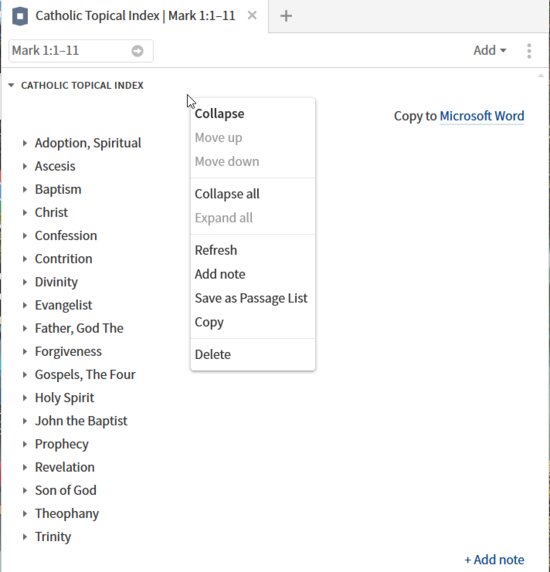
Help provides the usual mouse-over preview and click open of the Verbum Help section.
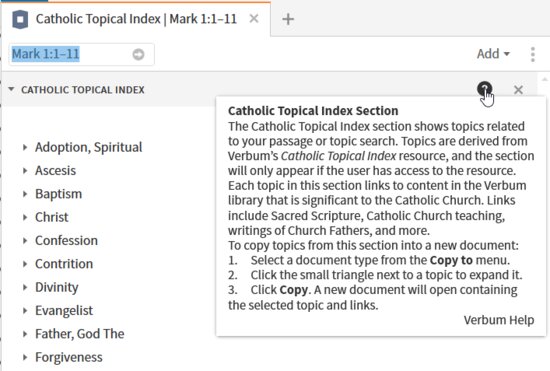
Contents
There is a special copy function built into the section which will be discussed in the interactions section below.
The data is arranged in the following hierarchy:
- Topic (undocumented)
- Text category (corpus) (documented)
- Work, author, or text classification as appropriate
- Specific reference
From documentation:
Categories include:
• Sacred Scripture: OT and NT texts.
• Church Teaching: Texts containing Church doctrine and tenets of Catholic faith.
• Liturgy: Books containing prayers, texts, and instructions for conducting a ritual or service.
• Canon Law: Documents issued by Church authority that govern Church operation.
• Ecclesiastical Writers: Authors of foundational Church texts.[2]
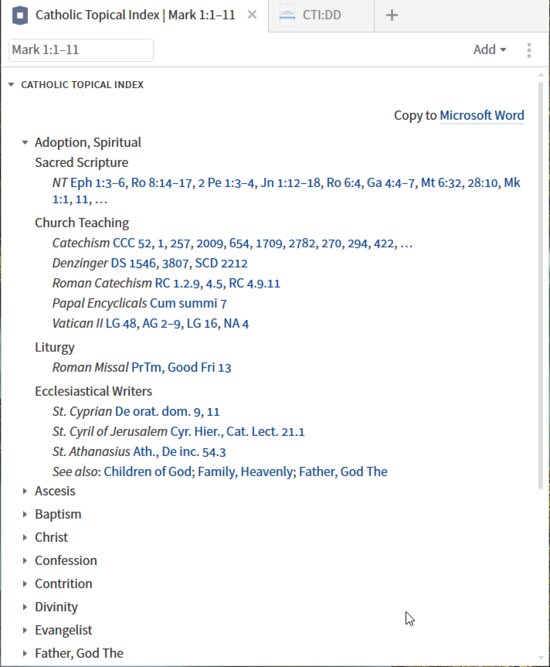
Note that the Catholic topics are not included in Factbook nor are they documented. However, many of the topics can be found in the Glossary of Catholic Church. Catechism of the Catholic Church. 2nd Ed. Washington, DC: United States Catholic Conference, 2000. For example:[quote]
ASCESIS: The practice of penance, mortification, and self-denial to promote greater self-mastery and to foster the way of perfection by embracing the way of the cross (2015).[3]
BAPTISM: The first of the seven sacraments, and the “door” which gives access to the other sacraments. Baptism is the first and chief sacrament of forgiveness of sins because it unites us with Christ, who died for our sins and rose for our justification. Baptism, Confirmation, and Eucharist constitute the “sacraments of initiation” by which a believer receives the remission of original and personal sin, begins a new life in Christ and the Holy Spirit, and is incorporated into the Church, the Body of Christ. The rite of Baptism consists in immersing the candidate in water, or pouring water on the head, while pronouncing the invocation of the Most Holy Trinity: the Father, the Son, and the Holy Spirit (977, 1213 ff.; 1275, 1278).[4]
CHRIST: From the Greek translation of the Hebrew Messiah, which means “anointed.” It became the name proper to Jesus because he accomplished perfectly the divine mission of priest, prophet, and King, signified by his anointing as Messiah, “Christ” (436). See Jesus Christ; Messiah; Anointing.[5]
Interactions on data
|
Visual cue
|
Data element
|
Action
|
Response
|
|
Arrowhead (triangle)
|
Topic (Catholic)
|
Click
|
Expand/contract the section below the heading (1)
|
|
Ellipses
|
Detail references
|
Click
|
Expand to show remainder of entries (2)
|
|
Blue text
|
Detail reference
|
Mouse-over
|
Show preview of content of reference in top priority resource containing the reference; gutter line showing the full (generic) title of the resource (3)
|
|
Click
|
Open the highest priority resource containing the reference to reference (3)
|
|
Right click
|
Open Context Menu on the reference
|
|
Drag and drop
|
Open the highest priority resource containing the reference to reference in the location selected by the user (3)
|
|
Blue text
|
Topic (after see also)
|
Mouse-over
|
Show preview of topic entry in Jones, Andrew, Robert Klesko, Louis St. Hilaire, and Jason Stellman, eds. Catholic Topical Index. Bellingham, WA: Verbum, 2013. (4)
|
|
Click
|
Open Jones, Andrew, Robert Klesko, Louis St. Hilaire, and Jason Stellman, eds. Catholic Topical Index. Bellingham, WA: Verbum, 2013 to the specified topic. (4)
|
|
Right click
|
|
|
Drag and drop
|
Open Jones, Andrew, Robert Klesko, Louis St. Hilaire, and Jason Stellman, eds. Catholic Topical Index. Bellingham, WA: Verbum, 2013 in the pane of the user’s choice to the specified topic. (4)
|
(1) Expand/contract arrowhead (triangle)
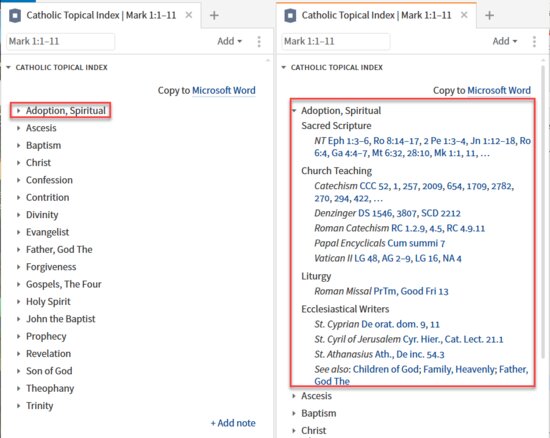
(2) expand (ellipses)
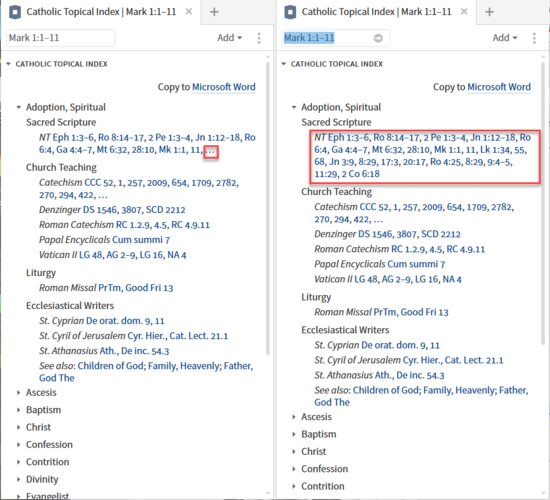
(3) reference detail
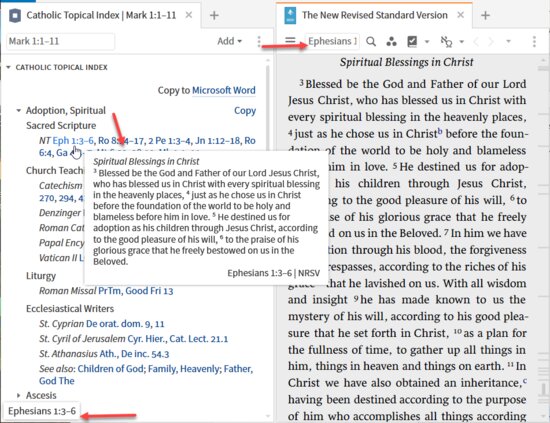
(4) Topic from “see also”
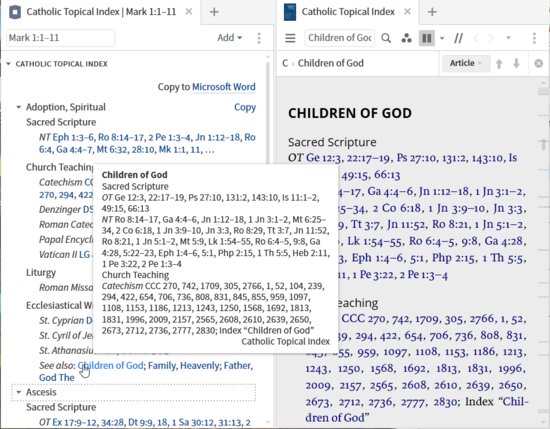
Copy
Section heading bar menu
While technically not a copy, the save as a passage list on the section heading bar menu serves a similar function.
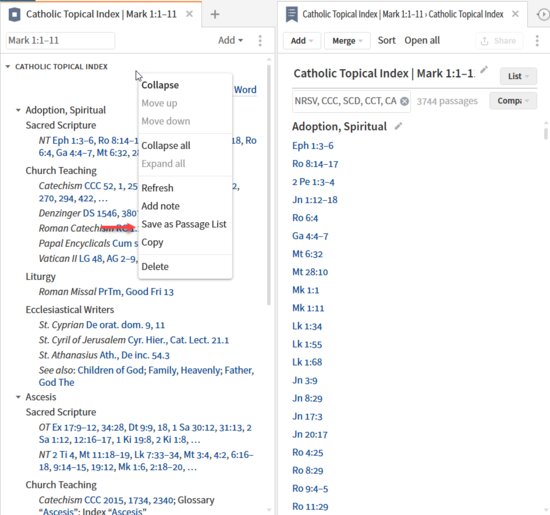
The section heading bar menu also offers a copy function (immediately below “Save as a Passage List” – see screenshot above). This copies the data to the clipboard which pastes as:[quote]
Catholic Topical Index
Adoption, Spiritual
Sacred Scripture
NT Eph 1:3–6, Ro 8:14–17, 2 Pe 1:3–4, Jn 1:12–18, Ro 6:4, Ga 4:4–7, Mt 6:32, 28:10, Mk 1:1, 11, Lk 1:34, 55, 68, Jn 3:9, 8:29, 17:3, 20:17, Ro 4:25, 8:29, 9:4–5, 11:29, 2 Co 6:18
Church Teaching
Catechism CCC 52, 1, 257, 2009, 654, 1709, 2782, 270, 294, 422, 460, 505, 537, 839, 1077, 1110, 1129, 1197, 1265, 1279, 1996, 2639, 2784, 2798, 2825; Index “Adoption”
Denzinger DS 1546, 3807, SCD 2212
Roman Catechism RC 1.2.9, 4.5, RC 4.9.11
Papal Encyclicals Cum summi 7
Vatican II LG 48, AG 2–9, LG 16, NA 4
Liturgy
Roman Missal PrTm, Good Fri 13
Ecclesiastical Writers
St. Cyprian De orat. dom. 9, 11
St. Cyril of Jerusalem Cyr. Hier., Cat. Lect. 21.1
St. Athanasius Ath., De inc. 54.3
See also: Children of God; Family, Heavenly; Father, God The
Ascesis
Sacred Scripture
OT Ex 17:9–12, 34:28, Dt 9:9, 18, 1 Sa 30:12, 31:13, 2 Sa 1:12, 12:16–17, 1 Ki 19:8, 2 Ki 1:8, 1 Ch 10:12, 2 Ch 20:3, Ezr 8:21–23, 9:1–8, 10:6, Ne 1:4, 9:1, Es 4:3, 16, 9:31, Ps 69:10, 109:24, Is 20:2, Je 36:9, 41:5, Eze 4:1–8, Da 6:18, Joe 1:14, 2:12, 15, Jon 3:5, 7, Zec 7:3, 5, 8:19
NT 2 Ti 4, Mt 11:18–19, Lk 7:33–34, Mt 3:4, 4:2, 6:16–18, 9:14–15, 19:12, Mk 1:6, 2:18–20, Lk 1:15, 2:36–37, 5:33–35, 18:12, Ac 13:2–3, 14:23, 1 Co 9:27, Col 2:20–23, 1 Ti 4:1–4, 8, Re 11:3
Church Teaching
Catechism CCC 2015, 1734, 2340; Glossary “Ascesis”; Index “Ascesis”
Papal Encyclicals Sac. cael. 78
Papal Documents RP 4, PDV 28, VC 8, 38, 103
Ecclesiastical Writers
St. Augustine Conf. 10.29.40
See also: Penance; Mortification; Fasting
Baptism
Christ
Confession
Contrition
Divinity
Evangelist
Father, God The
Forgiveness
Gospels, The Four
Holy Spirit
John the Baptist
Prophecy
Revelation
Son of God
Theophany
Trinity
Copy to function
The Copy to function built into the Catholic Topical Index allows copying into the following formats:
- Microsoft Word
- Microsoft PowerPoint
- LibreOffice Writer
- WordPad
- Passage List
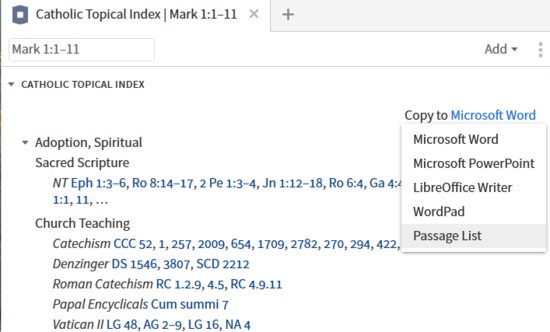
Note that the Copy command is at the topic level allowing the user to limit the content to a single topic.
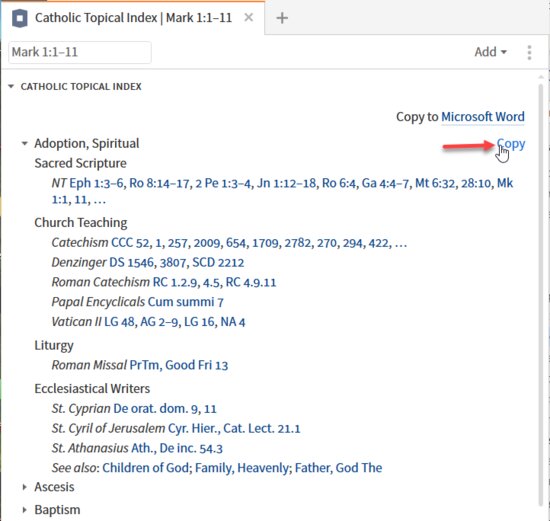
Clicking on Copy results in the following data being added to the active Microsoft Word document. (I’ve added an indent to set it apart.)[quote]
Adoption, Spiritual
Sacred Scripture
NT Eph 1:3–6, Ro 8:14–17, 2 Pe 1:3–4, Jn 1:12–18, Ro 6:4, Ga 4:4–7, Mt 6:32, 28:10, Mk 1:1, 11, Lk 1:34, 55, 68, Jn 3:9, 8:29, 17:3, 20:17, Ro 4:25, 8:29, 9:4–5, 11:29, 2 Co 6:18
Church Teaching
Catechism CCC 52, 1, 257, 2009, 654, 1709, 2782, 270, 294, 422, 460, 505, 537, 839, 1077, 1110, 1129, 1197, 1265, 1279, 1996, 2639, 2784, 2798, 2825; Index “Adoption”
Denzinger DS 1546, 3807, SCD 2212
Roman Catechism RC 1.2.9, 4.5, RC 4.9.11
Papal Encyclicals Cum summi 7
Vatican II LG 48, AG 2–9, LG 16, NA 4
Liturgy
Roman Missal PrTm, Good Fri 13
Ecclesiastical Writers
St. Cyprian De orat. dom. 9, 11
St. Cyril of Jerusalem Cyr. Hier., Cat. Lect. 21.1
St. Athanasius Ath., De inc. 54.3
See also: Children of God; Family, Heavenly; Father, God The
Note that the see also topics are not linked.
Search
This section depends on curated data with attributes not exposed to the user.
Supplemental materials
As Catholic Topics are not included in Factbook, there are no supplemental materials. The one relationship to remember is the definition of many of the topics in the glossary of the Catechism of the Catholic Church.
[1] Verbum Help (Bellingham, WA: Faithlife, 2018).
[2] Lydia Husser, Catholic Topical Index: Dataset Documentation (Bellingham, WA: Faithlife, 2017).
[3] Catholic Church, Catechism of the Catholic Church, 2nd Ed. (Washington, DC: United States Catholic Conference, 2000), 867.
[4] Catholic Church, Catechism of the Catholic Church, 2nd Ed. (Washington, DC: United States Catholic Conference, 2000), 867.
[5] Catholic Church, Catechism of the Catholic Church, 2nd Ed. (Washington, DC: United States Catholic Conference, 2000), 870.